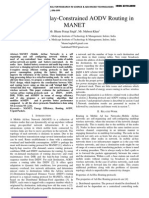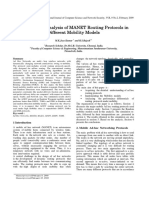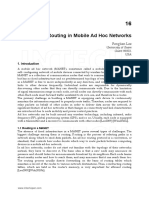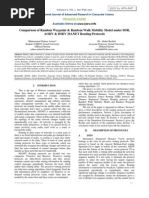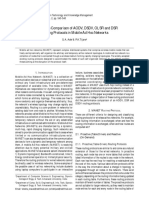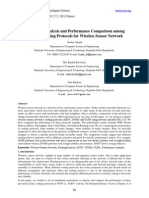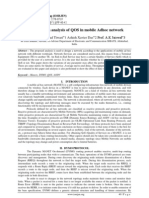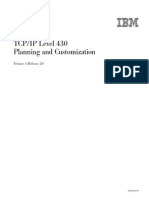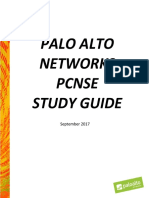0 ratings0% found this document useful (0 votes)
32 viewsHybrid 3
Hybrid 3
Uploaded by
Raaj KeshavThis document summarizes and compares the performance of two reactive MANET routing protocols (AODV and DSR) under varying pause times using the random waypoint mobility model. It describes the key characteristics and mechanisms of AODV and DSR, including how they establish and maintain routes. Simulation results show that the packet delivery ratio of both protocols remains high and similar until pause times exceed a certain threshold, after which performance declines.
Copyright:
© All Rights Reserved
Available Formats
Download as PDF, TXT or read online from Scribd
Hybrid 3
Hybrid 3
Uploaded by
Raaj Keshav0 ratings0% found this document useful (0 votes)
32 views4 pagesThis document summarizes and compares the performance of two reactive MANET routing protocols (AODV and DSR) under varying pause times using the random waypoint mobility model. It describes the key characteristics and mechanisms of AODV and DSR, including how they establish and maintain routes. Simulation results show that the packet delivery ratio of both protocols remains high and similar until pause times exceed a certain threshold, after which performance declines.
Original Description:
hybrid networks
Original Title
hybrid 3
Copyright
© © All Rights Reserved
Available Formats
PDF, TXT or read online from Scribd
Share this document
Did you find this document useful?
Is this content inappropriate?
This document summarizes and compares the performance of two reactive MANET routing protocols (AODV and DSR) under varying pause times using the random waypoint mobility model. It describes the key characteristics and mechanisms of AODV and DSR, including how they establish and maintain routes. Simulation results show that the packet delivery ratio of both protocols remains high and similar until pause times exceed a certain threshold, after which performance declines.
Copyright:
© All Rights Reserved
Available Formats
Download as PDF, TXT or read online from Scribd
Download as pdf or txt
0 ratings0% found this document useful (0 votes)
32 views4 pagesHybrid 3
Hybrid 3
Uploaded by
Raaj KeshavThis document summarizes and compares the performance of two reactive MANET routing protocols (AODV and DSR) under varying pause times using the random waypoint mobility model. It describes the key characteristics and mechanisms of AODV and DSR, including how they establish and maintain routes. Simulation results show that the packet delivery ratio of both protocols remains high and similar until pause times exceed a certain threshold, after which performance declines.
Copyright:
© All Rights Reserved
Available Formats
Download as PDF, TXT or read online from Scribd
Download as pdf or txt
You are on page 1of 4
Asha Ambhaikar et. al.
/ (IJ CSE) International J ournal on Computer Science and Engineering
Vol. 02, No. 09, 2010, 3021-3024
Scalability Performance of MANET Routing
Protocols with Reference to Variable Pause Time
Asha Ambhaikar
Rungta College of Engineering &
Technology
Bhilai, Chhattisgarh
India
H.R. Sharma
Chhatrapati Shivaji Institute of
Technology
Durg, Chhattisgarh
India
V.K.Mohabey
Kalyan PG College
Bhilai, Chhattisgarh
India
ABSTRACT- As mobile networking continues to experience
increasing popularity, the need to connect large numbers of wireless
devices will become more prevalent. Many recent proposals for ad
hoc routing have certain characteristics. A mobile ad hoc network is
a collection of autonomous mobile nodes that communicate with
each other over wireless links. Such networks does play important
role in civilian and military settings, being useful for providing
communication support where no fixed infrastructure exists or the
deployment of a fixed infrastructure is possible. It is a crucial part in
the performance evaluation of MANET to select suitable mobility
model and routing protocols. Therefore, a number of routing
protocols as well as mobility models have been proposed for ad hoc
wireless networks based on different scenarios. In this paper, we
study and compare the performance of the two reactive routing
protocols AODV and DSR with reference to varying Pause Time.
For experimental purposes, we have considered increasing Pause
Time from 5 sec to 40 sec and illustrate the performance of the
routing protocol across Packet Delivery Ratio parameter. Our
simulation result shows that both AODV & DSR is performing
equally good until the Pause Time cross a certain limit.
Keywords- AODV, DSR, RANDOM WAYPOINT, PACKET
DELIVERY RATIO, OVERHEAD, PAUSE TIME
1. INTRODUCTION
MANET is collection of wireless nodes that can
dynamically form a network to exchange the information
without any pre-existing fixed network Next generation of
mobile communications will include both prestigious
infrastructure wireless networks and novel infrastructure less
mobile ad hoc networks (MANETs). The special features of
MANET bring these technology great opportunities together
with severe challenges. Since the 1970s, wireless networks
have become increasingly popular in the computing industry.
This is particularly true within the past decade, which has seen
wireless networks being adapted to enable mobility. There are
currently two variations of mobile wireless networks. The first
is known as the infrastructure network (i.e., a network with
fixed and wired gateways). The bridges for these networks are
known as base stations. A mobile unit within these networks
connects to, and communicates with, the nearest base station
that is within its communication Radius. As the mobile travels
out of range of one base station and into the range of another,
a handoff occurs from the old base station to the new, and
the mobile is able to continue. Typical applications of this type
of network include office wireless local area networks
(WLANs) [1].
The second type of mobile wireless network is the
infrastructure less mobile network, commonly known as an
ad hoc network. Infrastructure less networks has no fixed
routers; all nodes are capable of movement and can be
connected dynamically in an arbitrary manner. Nodes of
these networks function as routers, which discover and
maintain routes to other nodes in the network. Example
applications of ad hoc networks are emergency search-and-
rescue operations, meetings or conventions in which persons
wish to quickly share information, and data acquisition
operations in inhospitable terrain [1].
2. ADHOC ROUTING PROTOCOLS
Ad hoc routing protocols can be characterized into two
categories: proactive and reactive (on-demand) [2]. Among
the tested protocols in this work, only DSDV is proactive and
the other two (DSR, AODV) are reactive. Proactive protocols
update route information periodically, while reactive ones
establish routes only when needed. [1]
A. Destination-Sequenced Distance Vector Routing
(DSDV)
DSDV is an improved version of traditional Distance
Vector routing algorithms. It prevents routing loops by adding
a sequence number to every destination entry in the routing
table. The table therefore contains the information of
destination, next hop, distance to the destination, and the
sequence number associated with the destination. Each node
periodically broadcasts its routing table to its neighbors. After
receiving updates from neighbor nodes, each node updates its
routing table by comparing sequence number of each entry. If
the received information is found to be more recent, it replaces
the old entry with the newly received one. Data traffic is
routed according to the (destination, next hop) pair in the
routing table. When a link to a next hop is broken, any route
through that next hop is immediately assigned an infinite value
with a new sequence number. When a node receives an
infinite count and has an equal or greater sequence number
with a finite metric, a route update broadcast is triggered.
Thus, real routes propagated from the newly located
destination will quickly replace the routes with infinite value
[3].
ISSN : 0975-3397 3021
Asha Ambhaikar et. al. / (IJ CSE) International J ournal on Computer Science and Engineering
Vol. 02, No. 09, 2010, 3021-3024
B. Ad hoc On-demand Distance Vector Routing (AODV)
AODV is an on-demand protocol, which initiate route
request only when needed. When a source node needs a route
to certain destination, it broadcasts a route request packet
(RREQ) to its neighbors. Each receiving neighbor checks its
routing table to see if it has a route to the destination. If it
doesnt have a route to this destination, it will re-broadcast the
RREQ packet and let it propagate to other neighbors. If the
receiving node is the destination or has the route to the
destination, a route reply (RREP) packet will be sent back to
the source node. Routing entries for the destination node are
created in each intermediate node on the way RREP packet
propagates back. A hello message is a local advertisement for
the continued presence of the node. Neighbors that are using
routes through the broadcasting node will continue to mark the
routes as valid. If hello messages from a particular node stop
coming, the neighbor can assume that the node has moved
away. When that happens, the neighbor will mark the link to
the node as broken and may trigger a notification to some of
its neighbors telling that the link is broken. In AODV, each
router maintains route table entries with the destination IP
address, destination sequence number, hop count, next hop ID
and lifetime. Data traffic is then routed according to the
information provided by these entries [4].
C. Dynamic Source Routing (DSR)
The key feature of DSR is the use of source routing, which
means the sender knows the complete hop-by-hop route to the
destination. The node maintains route caches containing the
source routes that it is aware of. Each node updates entries in
the route cache as and when it learns about new routes. The
data packets carry the source route in the packet headers. The
delay and throughput penalties of DSR are mainly attributed to
aggressive use of caching and lack of any mechanism to detect
expired stale routes or to determine the freshness of routes
when multiple choices are available. Aggressive caching,
however, helps DSR at low loads and also keeps its routing
load down. Several additional optimizations have been
proposed and evaluated to be very effective. These
improvements include:
Salvaging: An intermediate node can replace a failed route
in the data packet with route information in its own cache.
Gratuitous route repair: Source node notify the neigh-
bors the error found in its packet, in order to clean up similar
error in the caches of its neighbors.
Promiscuous listening: A node can update its own source
routes in cache by overhearing a packet not addressed to it.
The node also checks if the packet could be routed via it to
gain a shorter path [5].
3. RANDOM WAYPOINT MOBILITY MODEL
The random way point mobility model is simple and is
widely used to evaluate the performance of MANETs. The
random way point mobility model contains pause time
between changes in direction and/or speed. Once a Mobile
Node begins to move, it stays in one location for a specified
pause time. After the specified pause time is elapsed, the MN
randomly selects the next destination in the simulation area
and chooses a speed uniformly distributed between the
minimum speed and maximum speed and travels with a speed
v whose value is uniformly chosen in the interval (0, Vmax).
Vmax is some parameter that can be set to reflect the degree
of mobility. Then, the MN continues its journey toward the
newly selected destination at the chosen speed. As soon as the
MN arrives at the destination, it stays again for the indicated
pause time before repeating the process. The traveling
pattern of a mobile node using the random waypoint mobility
model starts at a randomly chosen point or position [6].
4. THE TRAFFIC AND SCENARIO GENERATOR
Continuous bit rate (CBR) [9] traffic sources are used. The
source-destination pairs are spread randomly over the
network. The mobility model uses Random Waypoint
mobility model in a 1020 m x 1020 m field with network load
of 4 packet/s whereas pause time is varied from 5 secs to 40
secs while keeping the network size constant at 100 nodes.
Here, each packet starts its journey from a random location to
a random destination with a randomly chosen speed. Once the
destination is reached, another random destination is targeted
after a pause. Simulations are run for 100 simulated seconds
whereas Maximum speed is 10 m/s.
5. PERFORMANCE METRICS
Following important metrics are evaluated-
Packet Delivery ratio (PDR) - Packet delivery ratio is
calculated by dividing the number of packets received by the
destination through the number of packets originated by the
CBR source.
Loss Packet Ratio (LPR) - Loss Packet Ratio is calculated
by dividing the number of packets that never reached the
destination through the number of packets originated by the
CBR source.
Routing Overhead Routing overhead, which measures the
ratio of total routing packets sent and the total number of
packets sent.
6. SIMULATION SETUP
Simulation has been carried out by Network Simulator 2.33.
In our simulation, we have used network load at the rate of 4
packets / s. Network size is kept constant at 100 nodes. Pause
Time is increased gradually from 5 sec to 40 secs.
In this simulation we wanted to investigate how the protocols
behave with increasing Pause Time.
ISSN : 0975-3397 3022
Asha Ambhaikar et. al. / (IJ CSE) International J ournal on Computer Science and Engineering
Vol. 02, No. 09, 2010, 3021-3024
TABLE 1. EVALUATION WITH VARYING NETWORK SIZE
Parameter Value
Protocols AODV, DSR
Simulation Time 100 s
Number of Nodes 100
Network Load 4 Packets / sec
Pause Time 5, 10, 15, 20, 25, 30, 35, 40 sec
Environment Size 1020 mx 1020 m
Traffic Type Constant Bit Rate
MaximumSpeed 10 m/ s
Mobility Model RandomWaypoint
Network Simulator NS 2.33
7. RESULTS AND DISCUSSIONS
During the simulation we have increased the pause time
gradually while keeping the network size constant at 100
nodes and recorded the performance of both the protocols.
We did this simulation for 100 secs with maximum 8 cbr
connections. Readings were taken for different pause times
(5, 10, 15, 20, 25, 30, 35, 40 secs). From the results it is
evident that as the pause time increases the Packet Delivery
ratio decreases, Loss Packet Ratio Increases and Routing
Overhead increases.
8. PERFORMANCE EVALUATION
It can be observed in figure 1 that, throughout the simulation
performance of AODV [14] are consistent till Pause time
reach 10 secs, and then it shows the drop in the PDR till
pause time of 15 secs. Again it shows the great improvement
till the pause time reach 20 secs, and then it shows a big drop
in performance till the pause time of 30 secs. PDR of AODV
is increased drastically as it reaches the pause time of 35 secs
and it performs consistently till the pause time of 40 secs. On
the other hand, DSR makes a poor start as compared to
AODV and reach a good level as it reach the pause time of 10
secs and after that in spite of ups and downs in the
performance, it maintains better PDR as compared to AODV
till the pause time reach 35 secs. DSR [29] shows a big drop
in PDR as it crosses the pause time of 35 secs.
It can be observed in figure 2, that Loss Packet Ratio in
AODV is always greater as compared to DSR from the pause
time of 10 secs to 35 secs, even though it can be observed
that performance of AODV [14] is drastically improved as
the pause time exceeds 35 secs., while DSR starts to perform
poorly at the same point.
After observing in figure 3, AODV is performing poorly in
terms of Routing Overhead [19] factor as compared to DSR
until it reaches pause time of 35 secs. Even though DSR
performs much better as compared to AODV, until a point
where pause time exceeds 35 secs.
Figure 1: Pause Time Vs Packet Delivery Ratio
Figure 2. Pause Time Vs Loss Packet Ratio
Figure 3: Pause Time Vs Routing Overhead
9. CONCLUSION AND FUTURE WORK
Above results illustrate that the performance of a routing
protocols varies widely across different network sizes and
hence the study results from one scenario cannot be applied
to other scenario. Hence we have to consider the pause time
required in an application while selecting a routing protocol.
Our simulation results have given an indication that AODV
performs better on bigger pause time with given scenario
while, DSR is performs better on lesser pause time with the
same scenario.
ISSN : 0975-3397 3023
Asha Ambhaikar et. al. / (IJ CSE) International J ournal on Computer Science and Engineering
Vol. 02, No. 09, 2010, 3021-3024
The future scope is to find out what factors are responsible
for these simulation results, as performance of AODV in
various situations as compared to DSR are not as expected.
Further simulation needs to be carried out for the
performance evaluation with not only increased pause time
but also varying other related parameters like Network size,
Network load, Speed, Mobility modes etc.
REFERENCES
[1] Charles E. Perkins, Elizabeth M. Royer, Ad hoc On Demand Distance
Vector Routing Protocol
[2] Elizabeth M. Royer, C.K. Toh, A Review of Current Routing Protocols
for Ad Hoc Mobile Wireless Networks
[3] Aditya Goel, Ajaii Sharma , Performance Analysis of Mobile Ad-hoc
Network Using AODV Protocol, International J ournal of Computer
Science and Security (IJ CSS), Volume (3): Issue (5), Page No.334
[4] Yasser Kamal Hassan, Mohamed HashimAbd El-Aziz, and Ahmed
Safwat Abd El-Radi , Performance Evaluation of Mobility Speed over
MANET Routing Protocols, International J ournal of Network Security,
Vol.11, No.3, PP.128{138, Nov. 2010, Page No.128
[5] Mamoun Hussein Mamoun, Performance Comparison of Mobile Ad-
hoc Network Routing Protocol, MCN 2007 Conference, November 7-
10, 2007 , Page No.07
[6] A.Boomarani Malany, V.R.Sarma Dhulipala, and RM.Chandrasekaran,
Throughput and Delay Comparison of MANET Routing Protocols,
Int. J . Open Problems Compt. Math., Vol. 2, No. 3, September 2009 ,
ISSN 1998-6262, Page No.461
[7] YU-DOO KIM, IL-YOUNG MOON, SUNG-J OON CHO, A
COMPARISON OF IMPROVED AODV ROUTING PROTOCOL
BASED ON IEEE 802.11 AND IEEE 802.15.4, J ournal of
Engineering Science and Technology Vol. 4, No. 2 (2009) 132 - 141,
Page No.132
[8] Natarajan Meghanathan, Impact of the Gauss-Markov Mobility Model
on Network Connectivity, Lifetime and Hop Count of Routes for
Mobile Ad hoc Networks, J OURNAL OF NETWORKS, VOL. 5, NO.
5, MAY 2010, Page No.509
[9] Nadia Qasim, Fatin Said, Hamid Aghvami, Mobile Ad Hoc
Networking Protocols Evaluation through Simulation for Quality of
Service, IAENG International J ournal of Computer Science, 36:1,
IJ CS_36_1_10
[10] Neeti Soni, Exploiting the need of Comparative study of routing
protocols and Misbehaving node in wireless network, Published in
International J ournal of Advanced Engineering & Application, J une
2010 Issue
[11] Ian D. Chakeres, Luke Klein-Berndt, AODVjr, AODV Simplified,
Mobile Computing and Communications Review, Volume 6, Number 3
[12] Rainer Baumann,, AODV, Presentation at ETH Zrich, April 2002
[13] Prabhakar Dhekne, Wireless Sensor Network, Talk at SASTRA,
Bhabha Atomic Research Centre, August 24, 2006
[14] The Network Simulator - ns-2, available at
http://www.isi.edu/nsnam/ns/.
[15] UCB/LBNL/VINT Network Simulator, http://www-
mash.cs.berkeley.edu/ns/.
[16] Trace graph website http://www. geocities.com/tracegraph
[17] E.L. Madruga, J .J . Garcia -Luna-Aceves. Scalable Multicasting: The
Core- Assisted Mesh Protocol. 1999.
[18] C-K Toh. Ad Hoc Mobile Wireless Networks, Protocols and systems.
Prentice Hall PTR. 2002. ISBN 0-13-007817-4.
[19] Anuj K. Gupta, Dr. Harsh Sadawarti, Dr. Anil K. Verma, Performance
analysis of AODV, DSR & TORA Routing Protocols, IACSIT
International J ournal of Engineering and Technology, Vol.2, No.2,
April 2010, ISSN: 1793-8236
[20] Petteri Kuosmanen, Classification of Ad Hoc Routing Protocols.
[21] Ian D. Chakeres, Elizabeth M. Belding-Royer, AODV Routing
Protocol Implementation Design.
[22] Stuart Kurkowski, Tracy Camp, Michael Colagrosso, MANET
Simulation Studies: The Incredibles, Mobile Computing and
Communications Review, Volume 1, Number 2, Page No.01
ISSN : 0975-3397 3024
You might also like
- Ft2Dr/De: Instruction Manual (WIRES-X Edition)Document53 pagesFt2Dr/De: Instruction Manual (WIRES-X Edition)Manuel Del Santo100% (1)
- Allen-Bradley Stratix 5700™ Network Address Translation (NAT)Document20 pagesAllen-Bradley Stratix 5700™ Network Address Translation (NAT)Max100% (1)
- DSDV and Aodv 2Document12 pagesDSDV and Aodv 2Amhmed BhihNo ratings yet
- Comparative Performance Analysis of Mobile Ad Hoc Networking Protocols For Different Mobility ModelsDocument14 pagesComparative Performance Analysis of Mobile Ad Hoc Networking Protocols For Different Mobility ModelsInternational Journal of Application or Innovation in Engineering & ManagementNo ratings yet
- Ijaiem 2014 06 16 34Document9 pagesIjaiem 2014 06 16 34International Journal of Application or Innovation in Engineering & ManagementNo ratings yet
- Comparison of Effectiveness of Aodv, DSDV and DSR Routing Protocols in Mobile Ad Hoc NetworksDocument4 pagesComparison of Effectiveness of Aodv, DSDV and DSR Routing Protocols in Mobile Ad Hoc NetworksAlwarsamy RamakrishnanNo ratings yet
- An Extensive Performance Analysis of CBRP, DSR and AODV Protocols For Dense and Sparse Topologies in MANETDocument11 pagesAn Extensive Performance Analysis of CBRP, DSR and AODV Protocols For Dense and Sparse Topologies in MANETIJERDNo ratings yet
- Performance Evaluation of MANET Through NS2 Simulation: Ayush Pandey and Anuj SrivastavaDocument6 pagesPerformance Evaluation of MANET Through NS2 Simulation: Ayush Pandey and Anuj SrivastavaSwatiNo ratings yet
- Simulation and Analysis of AODV and AOMDV Protocol During Link Breakage in MANET Using NS-2Document6 pagesSimulation and Analysis of AODV and AOMDV Protocol During Link Breakage in MANET Using NS-2Zele WondeNo ratings yet
- Performance Analysis of Reactive & Proactive Routing Protocols For Mobile Adhoc - Networks Name of First Author, Name of Second AuthorDocument7 pagesPerformance Analysis of Reactive & Proactive Routing Protocols For Mobile Adhoc - Networks Name of First Author, Name of Second Authorpiyushji125No ratings yet
- V2I30064Document9 pagesV2I30064editor_ijarcsseNo ratings yet
- A Study On Proactive Routing Protocol in Ad-Hoc Network: Hemagowri J., Baranikumari C., Brindha BDocument4 pagesA Study On Proactive Routing Protocol in Ad-Hoc Network: Hemagowri J., Baranikumari C., Brindha BRochmad HidayatNo ratings yet
- Ijaiem 2014 04 29 081Document7 pagesIjaiem 2014 04 29 081International Journal of Application or Innovation in Engineering & ManagementNo ratings yet
- Simulation of MANET Routing Protocols DSDV, DSR and AODV For Different Mobility ModelsDocument9 pagesSimulation of MANET Routing Protocols DSDV, DSR and AODV For Different Mobility ModelsInternational Journal of Application or Innovation in Engineering & ManagementNo ratings yet
- Compusoft, 3 (6), 957-960 PDFDocument4 pagesCompusoft, 3 (6), 957-960 PDFIjact EditorNo ratings yet
- NS2 Report - Analysis of AODV & DSDV Routing Protocol: Muhammad SamiDocument3 pagesNS2 Report - Analysis of AODV & DSDV Routing Protocol: Muhammad SamiSamiunnNo ratings yet
- L D ' N Q: Ocal Istance S Eighbouring UantificationDocument11 pagesL D ' N Q: Ocal Istance S Eighbouring UantificationJohn BergNo ratings yet
- Manet AssignmentDocument5 pagesManet AssignmentHolly AndersonNo ratings yet
- Study and Analysis of Throughput, Delay and Packet Delivery Ratio in MANET For Topology Based Routing Protocols (AODV, DSR and DSDV)Document5 pagesStudy and Analysis of Throughput, Delay and Packet Delivery Ratio in MANET For Topology Based Routing Protocols (AODV, DSR and DSDV)PremKumarNo ratings yet
- Comparison of Dymo - Aodv - DSR and DSDV Manet Routing Protocols Over Varying Traffic - IjreasDocument13 pagesComparison of Dymo - Aodv - DSR and DSDV Manet Routing Protocols Over Varying Traffic - IjreasWesly Sibagariang100% (1)
- Performance Effect of Mobility Speed On AODVDocument4 pagesPerformance Effect of Mobility Speed On AODVeditor_ijarcsseNo ratings yet
- IjrsatDocument4 pagesIjrsatSrikanth ShanmukeshNo ratings yet
- A Comparative Study of Broadcast Based Routing Protocols in Mobile Ad Hoc NetworksDocument6 pagesA Comparative Study of Broadcast Based Routing Protocols in Mobile Ad Hoc NetworksInternational Journal of Application or Innovation in Engineering & ManagementNo ratings yet
- Performance Analysis of MANET Routing Protocols in Different Mobility ModelsDocument8 pagesPerformance Analysis of MANET Routing Protocols in Different Mobility Modelsnazm basmNo ratings yet
- A New Algorithm For CR Protocols in Ad-Hoc Networks: Dr. Srinivasa Rao AngajalaDocument10 pagesA New Algorithm For CR Protocols in Ad-Hoc Networks: Dr. Srinivasa Rao AngajalaIjesat JournalNo ratings yet
- Drivers Proactive Routing ProtocolDocument15 pagesDrivers Proactive Routing ProtocolBasit KhanNo ratings yet
- Performance Comparison and Analysis of DSDV and AODV For MANETDocument6 pagesPerformance Comparison and Analysis of DSDV and AODV For MANETHippihippyNo ratings yet
- Ijettcs 2013 07 29 055Document6 pagesIjettcs 2013 07 29 055International Journal of Application or Innovation in Engineering & ManagementNo ratings yet
- Performance Evaluation of Ad Hoc Routing Protocols Using ns2 SimulationsDocument18 pagesPerformance Evaluation of Ad Hoc Routing Protocols Using ns2 SimulationsSurbhi YadavNo ratings yet
- Ccaes 2012Document6 pagesCcaes 2012Reddy SimiNo ratings yet
- Study of Distance Vector Routing Protocols For Mobile Ad Hoc NetworksDocument8 pagesStudy of Distance Vector Routing Protocols For Mobile Ad Hoc NetworksSai SaurabNo ratings yet
- UNIT 8:-Mobile Ad-Hoc Networks, Wireless Sensor NetworksDocument15 pagesUNIT 8:-Mobile Ad-Hoc Networks, Wireless Sensor NetworksVenkatesh PavithraNo ratings yet
- Performance Evaluation of MANET Routing Protocols Using Scenario Based Mobility ModelsDocument2 pagesPerformance Evaluation of MANET Routing Protocols Using Scenario Based Mobility ModelsTefeNo ratings yet
- Compusoft, 3 (12), 1369-1373 PDFDocument5 pagesCompusoft, 3 (12), 1369-1373 PDFIjact EditorNo ratings yet
- Simulation Analysis of AODV Routing Protocol of Manet Using OpnetDocument3 pagesSimulation Analysis of AODV Routing Protocol of Manet Using Opnetمحمود كريمNo ratings yet
- Routing in MANETsDocument25 pagesRouting in MANETsSubramanya Suresh GudigarNo ratings yet
- Performance Analysis of AODV, DSR and ZRP Protocols in Vehicular Ad-Hoc Network Using QualnetDocument5 pagesPerformance Analysis of AODV, DSR and ZRP Protocols in Vehicular Ad-Hoc Network Using QualnetInternational Journal of Application or Innovation in Engineering & ManagementNo ratings yet
- Ijaiem 2014 04 29 083Document9 pagesIjaiem 2014 04 29 083International Journal of Application or Innovation in Engineering & ManagementNo ratings yet
- Impact of Node Density and Mobility On The Performance of AODV and DSR in MANETSDocument6 pagesImpact of Node Density and Mobility On The Performance of AODV and DSR in MANETSKashif AmjadNo ratings yet
- Comparison of Random Waypoint & Random Walk Mobility Model Under DSR, AODV & DSDV MANET Routing ProtocolsDocument6 pagesComparison of Random Waypoint & Random Walk Mobility Model Under DSR, AODV & DSDV MANET Routing ProtocolszaheergulNo ratings yet
- Ijcses 040303Document10 pagesIjcses 040303ijcsesNo ratings yet
- Feasibility Study of DSDV and AODV Routing Protocols in Mobile Sensor NetworksDocument7 pagesFeasibility Study of DSDV and AODV Routing Protocols in Mobile Sensor NetworksSabin BhandariNo ratings yet
- A Comparison Study of Qos Using Different Routing Algorithms in Mobile Ad Hoc NetworksDocument4 pagesA Comparison Study of Qos Using Different Routing Algorithms in Mobile Ad Hoc NetworksEEE_ProceedingsNo ratings yet
- Efficient Analysis and Comparative Study of Routing Protocols in Wireless AD-Hoc Networking ManetDocument4 pagesEfficient Analysis and Comparative Study of Routing Protocols in Wireless AD-Hoc Networking ManeterpublicationNo ratings yet
- Performance Comparison of AODV, DSDV, OLSR and DSR Routing Protocols in Mobile Ad Hoc NetworksDocument4 pagesPerformance Comparison of AODV, DSDV, OLSR and DSR Routing Protocols in Mobile Ad Hoc Networksezhar saveroNo ratings yet
- Simulation of Ad-Hoc Networks Using DSDV, AODV and DSR Protocols and Their Performance ComparisonDocument6 pagesSimulation of Ad-Hoc Networks Using DSDV, AODV and DSR Protocols and Their Performance ComparisonKesav RameshKumarNo ratings yet
- RDMAR ProtocolDocument7 pagesRDMAR ProtocolSashwat PadhyNo ratings yet
- Performance Analysis of Reactive Routing Protocols in Mobile Ad Hoc NetworksDocument5 pagesPerformance Analysis of Reactive Routing Protocols in Mobile Ad Hoc NetworksmanoharNo ratings yet
- Comparative Study of Mobile Ad-Hoc Routing Algorithm With Proposed New AlgorithmDocument8 pagesComparative Study of Mobile Ad-Hoc Routing Algorithm With Proposed New AlgorithmRakeshconclaveNo ratings yet
- Comprehensive Evaluation of Aodv, DSR, GRP, Olsr and Tora Routing Protocols With Varying Number of Nodes and Traffic Applications Over ManetsDocument8 pagesComprehensive Evaluation of Aodv, DSR, GRP, Olsr and Tora Routing Protocols With Varying Number of Nodes and Traffic Applications Over ManetsInternational Organization of Scientific Research (IOSR)No ratings yet
- A Comparative Analysis of DSDV and DSR in Different Scenario of Mobile Ad Hoc NetworkDocument4 pagesA Comparative Analysis of DSDV and DSR in Different Scenario of Mobile Ad Hoc Networksurendiran123No ratings yet
- Performance Evaluation and Comparison of Aodv and AomdvDocument5 pagesPerformance Evaluation and Comparison of Aodv and AomdvBekka MahmoudiNo ratings yet
- Performance Evaluation of AODV, DSR, DYMO and ZRPDocument14 pagesPerformance Evaluation of AODV, DSR, DYMO and ZRPNguyen Huu DungNo ratings yet
- Report On Glom OsimDocument16 pagesReport On Glom OsimmanishNo ratings yet
- An Efficient Passive Approach For Quality of Service Routing in ManetsDocument6 pagesAn Efficient Passive Approach For Quality of Service Routing in Manetssurendiran123No ratings yet
- 9 Boshir Ahmed 61-71Document11 pages9 Boshir Ahmed 61-71iisteNo ratings yet
- Analysing The Interaction Between Mobility Model and Unipath Routing Protocols in Mobile Ad Hoc NetworksDocument7 pagesAnalysing The Interaction Between Mobility Model and Unipath Routing Protocols in Mobile Ad Hoc NetworkseditorijaiemNo ratings yet
- Comparision of Performance of Routing Protocol in Wireless Mesh NetworkDocument5 pagesComparision of Performance of Routing Protocol in Wireless Mesh NetworkVarun KaundinyaNo ratings yet
- Ijret - Performance Analysis of Aodv, Olsr, GRP and DSR Routing Protocols With Database Load in ManetDocument9 pagesIjret - Performance Analysis of Aodv, Olsr, GRP and DSR Routing Protocols With Database Load in ManetInternational Journal of Research in Engineering and TechnologyNo ratings yet
- Data Variation Analysis of QOS in Mobile Adhoc NetworkDocument3 pagesData Variation Analysis of QOS in Mobile Adhoc NetworkIOSRJEN : hard copy, certificates, Call for Papers 2013, publishing of journalNo ratings yet
- Aodv and DSRDocument6 pagesAodv and DSRRavi VermaNo ratings yet
- NmapDocument55 pagesNmapyogesh2377No ratings yet
- Profile _ MynaukriDocument3 pagesProfile _ Mynaukrispectra.amitpNo ratings yet
- Electronic Age and New Information AgeDocument31 pagesElectronic Age and New Information AgeArvie Jariz PayoNo ratings yet
- SBL-1 PDFDocument2 pagesSBL-1 PDFfox7878No ratings yet
- Panasonic Ip Dect DatasheetDocument2 pagesPanasonic Ip Dect Datasheetashraf8588No ratings yet
- Beam Forming@001Document3 pagesBeam Forming@001Srikumar T BNo ratings yet
- Bio ChipDocument16 pagesBio ChipAnil KumarNo ratings yet
- Mini Project 231-3Document11 pagesMini Project 231-3Jillella PranayNo ratings yet
- IP Plan - IBMDocument737 pagesIP Plan - IBMFarhan Ahmed KhanNo ratings yet
- Dan Malek,: Advanced Data Network Solutions With LinuxDocument20 pagesDan Malek,: Advanced Data Network Solutions With LinuxaaaaNo ratings yet
- 01-OBA000100 GPON FundamentalsDocument49 pages01-OBA000100 GPON FundamentalsWassim AdraNo ratings yet
- 20 IoDocument21 pages20 IoKarthi KeyanNo ratings yet
- Se342: Distributed Computing: Lecture # 03-b Fundamental ModelsDocument26 pagesSe342: Distributed Computing: Lecture # 03-b Fundamental ModelsMahmood SyedNo ratings yet
- PRC-47 - 35 ManDocument590 pagesPRC-47 - 35 ManelectronbulbNo ratings yet
- 2.1.1.5 Packet Tracer - Create A Simple Network Using Packet TracerDocument6 pages2.1.1.5 Packet Tracer - Create A Simple Network Using Packet TracerGrandmaster MeowNo ratings yet
- 05 - N FarfanDocument22 pages05 - N FarfanlucynleinNo ratings yet
- A Guide To Email For BeginnersDocument9 pagesA Guide To Email For BeginnersossomansNo ratings yet
- PCNSE Study Guide PDFDocument134 pagesPCNSE Study Guide PDFrikrdo151No ratings yet
- Deployment Best Practice Guide: Milestone Xprotect VmsDocument109 pagesDeployment Best Practice Guide: Milestone Xprotect VmsKK WongNo ratings yet
- Security Part 1. Auditing Operating Systems and NetworkDocument1 pageSecurity Part 1. Auditing Operating Systems and Networkjung_seohyunNo ratings yet
- C6 ROUTER enDocument8 pagesC6 ROUTER enPaul Ramos CarcaustoNo ratings yet
- Blockchain Name Service: Tushar Dnyandev Adivarekar Disha Hegde Prof. Suvarna BhoirDocument5 pagesBlockchain Name Service: Tushar Dnyandev Adivarekar Disha Hegde Prof. Suvarna BhoirJean SunnyNo ratings yet
- CSCF4532BDocument1 pageCSCF4532BSeokjin KongNo ratings yet
- Evolution of InternetDocument8 pagesEvolution of InternetSumi RoyNo ratings yet
- NSN Role Model 3G Site Reserves-3rd April 08Document7 pagesNSN Role Model 3G Site Reserves-3rd April 08Emad SaadNo ratings yet
- CDT-5141D-3 - ViBE CP6000 Contribution Platform - Data SheetDocument2 pagesCDT-5141D-3 - ViBE CP6000 Contribution Platform - Data SheetJohnnyNo ratings yet
- Module - 2 (Cyber Security)Document9 pagesModule - 2 (Cyber Security)pappi badigerNo ratings yet
- Training RelayDocument57 pagesTraining Relayyusuf2307100% (2)





















